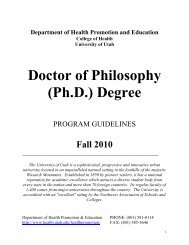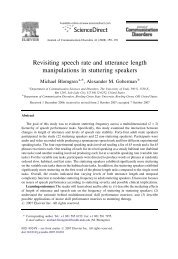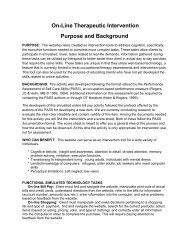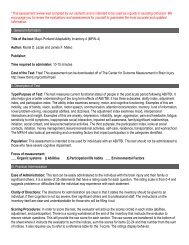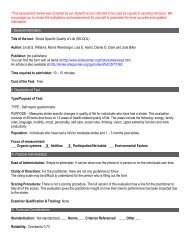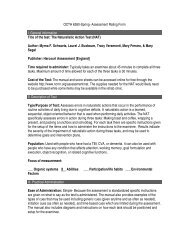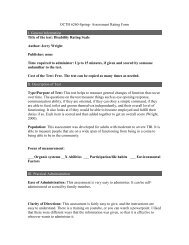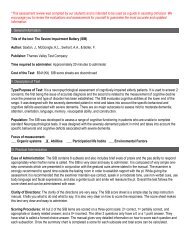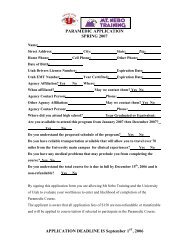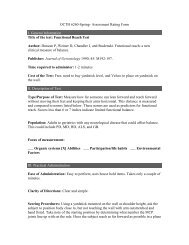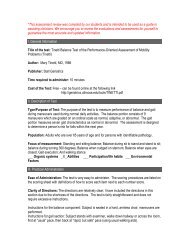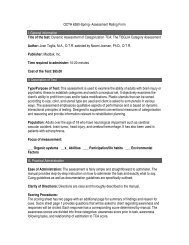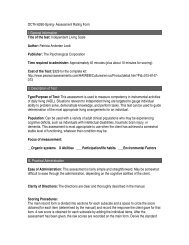OCTH 6260-Spring- Assessment Rating Form
OCTH 6260-Spring- Assessment Rating Form
OCTH 6260-Spring- Assessment Rating Form
You also want an ePaper? Increase the reach of your titles
YUMPU automatically turns print PDFs into web optimized ePapers that Google loves.
I. General InformationTitle of the test: Contextual Memory Test (CMT)Author: Joan P. TogliaPublisher: Therapy Skill Builders<strong>OCTH</strong> <strong>6260</strong>-<strong>Spring</strong>- <strong>Assessment</strong> <strong>Rating</strong> <strong>Form</strong>Time required to administer: 10-20 minutes (Part I), 15-20 minute delay if additional testing isneeded.Cost of the Test:Complete kit includes: manual, 2 test cards, 14 cut-apart sheets (80 picture cards), 25 scoresheets, vinyl carrying case - $142.00Additional score sheets: pkg of 25 - $55.50II. Description of TestType/Purpose of Test: Interview / Questionnaire format; designed to objectively investigateawareness and strategy use in adults with memory impairment. It assesses three related areas ofmemory which include: awareness of memory capacity, recall of line-drawn items, and strategyuse. This is a dynamic assessment where the examiner can provide cues and use strategies tooptimize the client’s performance. It can also be used as a screening tool to identify if a client has amemory deficit and whether further investigation is needed.Population: The CMT was developed for adults 18 years of age and older with a neurological ororganic memory impairment. This includes people with head trauma, cerebral vascular disorders,dementia, multiple sclerosis, Parkinson’s disease, brain tumor, AIDS, epilepsy, or chronic alcoholabuse.Focus of measurement:___ Organic systems _x_ Abilities ___ Participation/life habits ___ Environmental FactorsIII. Practical AdministrationEase of Administration: Fairly easy to administer once the administration protocol is understood.Scoring and interpretation is more complex.Clarity of Directions: The manual is lengthy and somewhat confusing. Although theadministration protocol is easy to follow, the scoring and interpretation processes are difficult tounderstand.Scoring Procedures:1. Administer the assessment and record the responses into the appropriate columns on thescore card.
2. Convert the recall scores into standard scores and compare them to normativeperformance (table 8).3. Classify standard scores into the categories of WNL, suspect, mild, moderate, or severe.Examiner Qualification & TrainingNo certification required. Examiner should be familiar with the administration protocol andunderstand how to use a dynamic assessment. This includes providing cues to the client andidentifying strategies to help the client optimize his or her performance. The examiner should alsohave a good understanding of the scoring and interpretation because it can be complicated.IV. Technical ConsiderationsStandardization: _X_ Norms ____ Criterion Referenced ____ Other __________________Reliability:• Good reliability (.73-.81) between immediate, delayed and total scores compared betweennon-context and context versions; moderate to highly moderate.• Test re-test reliability shown to be highly reliable (control .74-.87 vs. .85-.94)• Predictive scores were found to be highly reliable (.90)• Strategy scores had high correlation between the two versions (.75)Validity:• Good concurrent reliability was established when immediate, delayed, and total recall scoreswere correlated with RBMT• Show to have the ability to discriminate between individuals who are non-disabled and thosewith brain injuryManual: ____ Excellent __x__ Adequate ____ PoorWhat is (are) the setting/s that you would anticipate using this assessment?Hospitals, rehab facilities, outpatient clinics, etcSummary of strengths and weaknesses:Weaknesses:• Not standardized on general population; additional research required on psychometrictesting• It is not diagnostic; must be used in conjunction with other tests of memory and cognitionsuch as Rivermead Behavioral Memory Test• Manual is confusing and lengthy• Scoring and interpretation of results are difficult• Inappropriate tool for individuals with moderate or severe aphasia or visual perceptualdeficits• May affected by language or cultural barriers if the client is unable to recognize or namethe items
Strengths:• Easy to administer (5-10 minutes)• Easy to transport (can be used at bedside)• Screens for memory dysfunction• Uses pictures of everyday objects• Provides objective measures of awareness and strategy use• Screens for memory dysfunction• Links assessment results with treatment and suggests areas for additional testing• Based on the theory of memory• Allows for contextual prompts• Allows for alternative description names• Adaptations made for language barriers and clients with dysphasia• Flexible in testing procedures (recall vs. recognition)References:Toglia, J.P. (1993). Contextual Memory Test. San Antonio, TX: Therapy Skill Builders.



